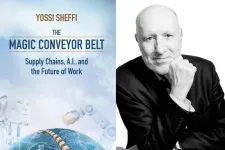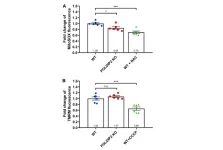(Press-News.org) High levels of the body’s own cannabinoid substances protect against developing addiction in individuals previously exposed to childhood maltreatment, according to a new study from Linköping University in Sweden. The brains of those who had not developed an addiction following childhood maltreatment seem to process emotion-related social signals better.
Childhood maltreatment has long been suspected to increase the risk of developing a drug or alcohol addiction later in life. Researchers at Linköping University have previously shown that this risk is three times higher if you have been exposed to childhood maltreatment compared with if you have not, even when accounting for confounds from genetics and other familial factors.
“There’s been a lot of focus on addiction as a disease driven by a search for pleasure effects and euphoria, but for many it has more to do with the drugs’ ability to suppress negative feelings, stress sensitivity, anxiety and low mood. Based on this, we and other researchers have had a theory that if affected in childhood, the function of the brain’s distress systems is altered, and that this may contribute to addiction risk in adulthood,” says Markus Heilig, professor and director of the Center for Social and Affective Neuroscience, CSAN, at Linköping University and consultant at the Psychiatric Clinic of the University Hospital in Linköping.
Endocannabinoids, i.e. the body’s own cannabis-like substances, are an interesting player in this context. The endocannabinoid system plays an important part in regulating reactions to stress and discomfort. Recent research suggests that this endogenous system may function as a stress buffer.
The researchers behind the study, published in Molecular Psychiatry, aimed to investigate possible mechanisms behind susceptibility or resilience to developing substance use disorder later in life after exposure to childhood maltreatment. One difficulty in research is that people who develop problems later in life tend to overreport negative life experiences when questioned about earlier events. The researchers therefore used psychiatric care registers of children and young people having been treated for traumatic childhood experiences to find study participants with objectively and prospectively documented exposure. The study included about 100 young adults divided into four equal sized groups: individuals that had been exposed to childhood maltreatment and had developed an addiction, individuals that had been exposed but had not, individuals that had not been exposed but had developed an addiction, and individuals who had neither been exposed nor developed an addiction. The researchers measured endocannabinoid levels in participants’ blood and carried out several experiments to test stress reactions. The participants’ brains were also scanned using magnetic resonance imaging, MRI, while their reactions to social stimuli were tested.
It turned out that one group stood out compared to the other three: the group that had experienced childhood maltreatment but had not later developed an addiction. The researchers refer to this group as ‛resilient’. In comparison with the other groups, this group showed increased function of the endocannabinoid system as well as different brain activity. Surprisingly, the resilient group differed most from the control group, which had not been exposed to childhood maltreatment, nor had any addictions.
Faced with emotional social stimuli, the resilient group showed higher activity in three areas of the brain. Two of these areas are part of a brain network that focuses attention and cognitive abilities on what is important at the moment and modifies individuals’ behaviour according to the situation at hand. The third area of the brain is in the frontal lobe and is associated with regulating emotions. This area communicates extensively with other areas in the brain that process emotions. In comparison with other animals, humans have a well-developed frontal lobe that regulates impulses and emotions, for instance by suppressing fear impulses in situations where fear is not relevant.
“Increased activity in certain areas of the brain in the resilient group, which had not developed an addiction despite childhood maltreatment, may be linked to a more adaptive way of reacting to emotional social information. We can see that also in a resting state they show increased communication between the frontal lobes and other parts of the brain, which could indicate that this group has better emotional regulation,” says Irene Perini, staff scientist at CSAN at Linköping University.
A question this discovery raises is whether the resilient group had a high endocannabinoid system function from the outset, or whether they were better able to activate the system in response to stress, thereby avoiding long-term consequences of childhood maltreatment. Because of its cross-section nature, this is not possible to determine from the present study.
The study was funded by, among others, the Swedish Research Council, Knut and Alice Wallenberg Foundation, Region Östergötland, Linköping University, Systembolaget’s Alcohol Research Council and the Brain & Behaviour Research Foundation NARSAD Young Investigator Grant. It was carried out by Markus Heilig’s research group at CSAN. Irene Perini is the lead author together with Leah Mayo, previously with CSAN at LiU, and currently professor at the University of Calgary in Canada.
Article: Resilience to substance use disorder following childhood maltreatment: association with peripheral biomarkers of endocannabinoid function and neural indices of emotion regulation, Irene Perini, Leah M. Mayo, Andrea J. Capusan, Elisabeth R. Paul, Adam Yngve, Robin Kämpe, Emelie Gauffin, Raegan Mazurka, Bijar Ghafouri, Niclas Stensson, Anna Asratian, Paul J. Hamilton, Åsa Kastbom, Per A. Gustafsson and Markus Heilig, Molecular Psychiatry, published online April 12 2023, doi: 10.1038/s41380-023-02033-y
END
The brain’s cannabinoid system protects against addiction following childhood maltreatment
2023-04-12
ELSE PRESS RELEASES FROM THIS DATE:
Pregnant women show robust and variable immunity during COVID-19
2023-04-12
New research from the Peter Doherty Institute for Infection and Immunity (Doherty Institute) has found that pregnant women display a strong immune response to SARS-CoV-2 infection, comparable to that of non-pregnant women.
Published in JCI Insight, the study looked at the immune responses to SARS-CoV-2 in unvaccinated pregnant and non-pregnant women and found similar levels of antibodies and T and B cell responses, responsible for long-term protection.
Lead author of the paper, University of ...
Antimicrobial stewardship programs essential for preventing C. difficile in hospitals
2023-04-12
ARLINGTON, Va. (April 12, 2023) — Five medical organizations say it is essential that hospitals establish antimicrobial stewardship programs to prevent Clostridioides difficile (C. difficile) infections. These infections, linked to antibiotic use, cause difficult-to-treat diarrhea, longer hospital stays, and higher costs. C. difficile infections are fatal for more than 12,000 people in the United States each year.
Strategies to Prevent Clostridioides difficile Infections in Acute Care Hospitals: 2022 Update, gives evidence-based, ...
Mitochondria power-supply failure may cause age-related cognitive impairment
2023-04-12
LA JOLLA—(April 12, 2023) Brains are like puzzles, requiring many nested and codependent pieces to function well. The brain is divided into areas, each containing many millions of neurons connected across thousands of synapses. These synapses, which enable communication between neurons, depend on even smaller structures: message-sending boutons (swollen bulbs at the branch-like tips of neurons), message-receiving dendrites (complementary branch-like structures for receiving bouton messages), and power-generating mitochondria. To create a cohesive brain, all these pieces must be accounted for.
However, in the aging brain, these ...
Education and peer support cut binge-drinking by National Guard members in half, study shows
2023-04-12
A new study shows promise for reducing risky drinking among Army National Guard members over the long term, potentially improving their health and readiness to serve.
The number of days each month that Guard members said they had been binge-drinking dropped by up to half, according to the new findings by a University of Michigan team published in the journal Addiction.
The drop happened over the course of a year among Guard members who did multiple brief online education sessions designed for members of the military, and among those who did an initial online education session followed by supportive ...
World’s biggest cumulative logjam, newly mapped in the Arctic, stores 3.4 million tons of carbon
2023-04-11
WASHINGTON — Throughout the Arctic, fallen trees make their way from forests to the ocean by way of rivers. Those logs can stack up as the river twists and turns, resulting in long-term carbon storage. A new study has mapped the largest known woody deposit, covering 51 square kilometers (20 square miles) of the Mackenzie River Delta in Nunavut, Canada, and calculated that the logs store about 3.4 million tons (about 3.1 million metric tons) of carbon.
“To put that in perspective, that’s about two and a half million ...
Life cycle assessment can help with the transition to the circular economy
2023-04-11
According to Bening Mayanti's doctoral dissertation at the University of Vaasa, the use of life cycle assessment combined with economic models can help companies to take steps toward the circular economy.
– We often hear claims about some solutions being circular, sustainable, or green. Instead of blindly accepting those claims, we should ask justifications, ‘How so?’ says Mayanti, who publicly defended her dissertation on Wednesday, 5 April.
Before deciding on circular economy solutions and building supply chains, it is worth doing a careful analysis. ...
From waste to wonder: unlocking nature’s biochemical recycling secrets
2023-04-11
A new perspective published in the journal Nature Chemical Biology uncovers a previously unknown biochemical recycling process in animals. The authors review a flurry of recent papers demonstrating that animals extensively recycle biochemical waste to produce novel chemicals that play key roles in biology, from regulating behavior to development and aging.
These studies show that the genes previously thought to code for carboxylesterases, enzymes that hydrolyze esters, actually play a pivotal role in assembling a wide range of new metabolites from building blocks generally considered “cellular waste.” Surprisingly, the so-called carboxylesterases were found to contribute ...
Yossi Sheffi on AI and the future of the supply chain
2023-04-11
Global supply chains are immense feats of technological and organizational sophistication. They are also, as the onset of the Covid-19 pandemic showed, vulnerable to unexpected developments. Will that change as artificial intelligence becomes a bigger part of supply chains? And what will happen to workers in the process?
MIT Professor Yossi Sheffi explores these topics in a new book, “The Magic Conveyor Belt: AI, Supply Chains, and the Future of Work,” published by MIT’s CTL Media. Sheffi, the Elisha Gray II Professor of Engineering ...
Tax credit tool tracks EV savings
2023-04-11
Oak Ridge National Laboratory researchers have developed an online resource to help consumers understand the electric vehicle tax credits available through the Inflation Reduction Act.
Located on the Department of Energy’s fueleconomy.gov website, the tool shows eligible vehicle models along with the corresponding federal tax credit.
The new clean vehicle tax credit is for purchases of all-electric, plug-in hybrid electric and fuel cell electric vehicles in 2023 and beyond. A separate credit is available for eligible used vehicles purchased in 2023 or after. Information on credits for vehicles purchased before ...
Knockout of AMD-associated gene POLDIP2 reduces mitochondrial superoxide in retinal cells
2023-04-11
“To our knowledge, this is the first functional study of POLDIP2 in retinal cells to understand its potential role in AMD.”
BUFFALO, NY- April 11, 2023 – A new research paper was published in Aging (listed by MEDLINE/PubMed as "Aging (Albany NY)" and "Aging-US" by Web of Science) Volume 15, Issue 6, entitled, “Knockout of AMD-associated gene POLDIP2 reduces mitochondrial superoxide in human retinal pigment epithelial cells.”
Genetic and epidemiologic studies have significantly advanced our ...








